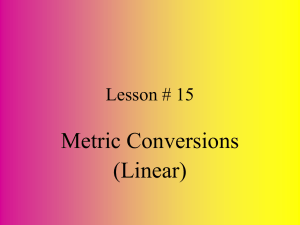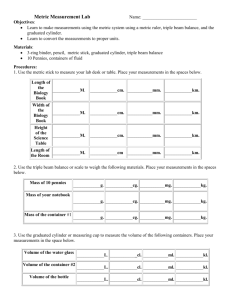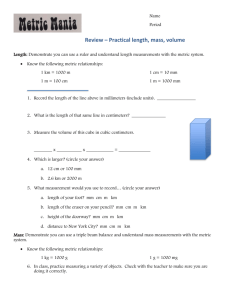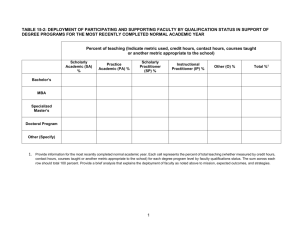Lab Activity: Measuring with Metric
advertisement
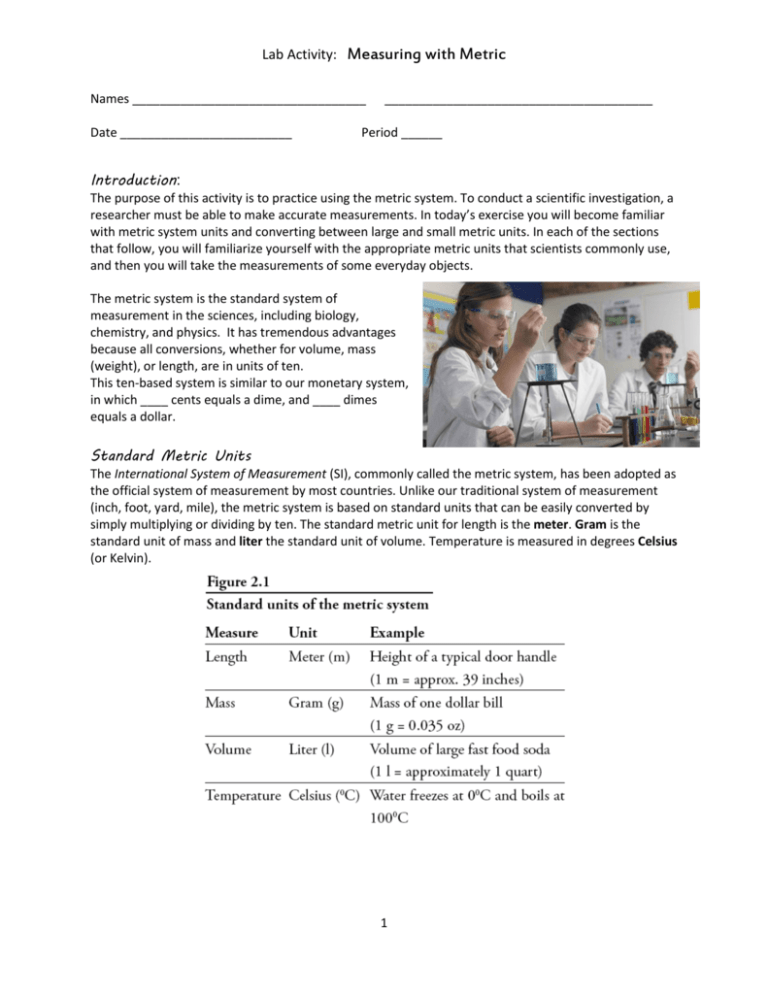
Lab Activity: Measuring with Metric Names __________________________________ Date _________________________ _______________________________________ Period ______ Introduction: The purpose of this activity is to practice using the metric system. To conduct a scientific investigation, a researcher must be able to make accurate measurements. In today’s exercise you will become familiar with metric system units and converting between large and small metric units. In each of the sections that follow, you will familiarize yourself with the appropriate metric units that scientists commonly use, and then you will take the measurements of some everyday objects. The metric system is the standard system of measurement in the sciences, including biology, chemistry, and physics. It has tremendous advantages because all conversions, whether for volume, mass (weight), or length, are in units of ten. This ten-based system is similar to our monetary system, in which ____ cents equals a dime, and ____ dimes equals a dollar. Standard Metric Units The International System of Measurement (SI), commonly called the metric system, has been adopted as the official system of measurement by most countries. Unlike our traditional system of measurement (inch, foot, yard, mile), the metric system is based on standard units that can be easily converted by simply multiplying or dividing by ten. The standard metric unit for length is the meter. Gram is the standard unit of mass and liter the standard unit of volume. Temperature is measured in degrees Celsius (or Kelvin). 1 Lab Activity: Measuring with Metric Figure 2.2 shows the metric units and their prefixes. Measurements are further expressed using a “superunit” prefix or subunit prefix. Superunits contain Greek prefixes to show multiples of the base unit, so they make the base unit larger. Latin prefixes, on the other hand, represent “subunits” that make the base unit smaller. Metric Conversions Conversions within the metric system can be made easily using a metric staircase. Each step of the staircase represents a ten-fold change in the value of the measure or a shift of the decimal point one place. Therefore, each step you move down the staircase represents multiplication by ten or a movement of the decimal one place to the right. Each step up the staircase represents a division by ten or the movement of the decimal point one place to the left. Two steps up or down the staircase represents a movement of the decimal point two places to the left or right and three steps up or down the staircase represents a movement of the decimal point three places to the left or right. If you have trouble, ask your instructor to demonstrate how to make conversions within the metric system using the staircase. 2 Lab Activity: Measuring with Metric Heed these rules: 1. You should always use DECIMALS (never fractions!) to express metric measurements. For example: write 2.25 cm, not 2 ¼ cm 2. If a metric measurement is less than one, precede the decimal with a ZERO. For example, don’t write .55 mm, write 0.55 mm Points will be deducted for incorrect format. Practice converting Metric Units Use the staircase diagram Figure 2.3 to convert the following metric units into new metric units. µl µl Metric units of length measurement most commonly used in biology include the meter (m), centimeter (cm), millimeter (mm), micrometer (µm), and nanometer (nm). See Table 2.1, below. Table 2.1 Metric Units of Length Measurement Unit Meters Centimeters Millimeters Meter (m) Centimeter (cm) Millimeter (mm) Micrometer (µm) Nanometer (nm) 1000 mm 10 mm 1.0 mm -3 0.001 (10 ) mm -6 0.000001 (10 ) mm 1m -2 0.01 (10 ) m -3 0.001 (10 ) m -6 0.000001 (10 ) m -9 0.000000001 (10 ) m 100 cm 1 cm 0.1 cm -4 0.0001 (10 ) cm -7 0.0000001 (10 ) cm Relative Size largest smallest How many cm are in a meter? _________ How many mm are in a centimeter? _________ How many µm are in a millimeter? __________ How many nm are in a micrometer? _________ 3 Lab Activity: Measuring with Metric Meter, Centimeter, and Millimeter 1. Obtain a meter stick. On the opposite side find the English measurement units of “inches”. How many inches are in a meter? ______. Therefore, one meter is roughly equivalent to a yard. Figure 2.4 Meter stick 2. Turn the meter stick over and observe the metric subdivisions (Fig. 2.4). How many centimeters are in a meter? ______ The prefix centi- means 100. How many cents (pennies) are in a dollar? ______ 3. How many millimeters are in a centimeter? ________. The prefix milli- means a thousand. How many millimeters are in a meter? ________. 4. For measuring smaller objects, it is preferable to use a metric ruler, rather than a meter stick. Obtain a penny. Measure its diameter ________, then its width (thickness) ________. 5. Why is it preferable to measure a penny in millimeters rather than centimeters or meters? ____________________________________________________________________________________ Use a meter stick or a metric ruler to measure the following: Width of classroom door opening (in meters) _______ m Length of whiteboard (in meters) _______ m Length of a dollar bill (in centimeters) _______ cm Width of your pen (in millimeters) _______ mm Which of your fingernails is closest to 1 cm in width? __________ Millimeter, Micrometer, and Nanometer As you will discover in upcoming laboratory exercises (using microscopes), the units micrometer (µm) and nanometer (nm) are useful in microscopy for measuring very tiny objects like cells or even viruses. Figure 2.5 shows that cells are generally much smaller than a millimeter (mm). Figure 2.5 Measuring Small Objects 4 Lab Activity: Measuring with Metric Use a metric ruler marked in centimeters (cm) and millimeters (mm). Micrometers (µm) are not marked on the ruler, but remember that 1000 µm would fit in between each millimeter hashmark. Figure 2.6 Measure the Circle 1. Measure the diameter of the circle (Fig 2.6). ________mm 2. Now, calculate its diameter in micrometers: ___________ µm 3. What is the diameter of the circle in nanometers? __________ nm The basic unit of volume in the metric system is the liter (symbol is L or l). The most common derived unit used for small amounts of liquids is the milliliter (mL) (10-3 or 1/1000 of a liter). A typical individual bottle of spring water might hold 500 mL (half a liter) of liquid. The volume of a milliliter is equal to the volume of a cube 1 centimeter per side. Sometimes these are expressed as cc (cubic centimeters) such as on the side of a medical syringe. Another even smaller unit often used in the medical field is the microliter (μL) (10-6 or 1/1,000,000 of a liter). For example, you might expect to find 5 million red blood cells in a microliter of your blood. 1. Volume measurements can be related to those of length. Use a metric ruler to measure a wooden block. Record the measurements below. Length = ____ cm width = _____ cm depth (height) = _____ cm The volume (or space) occupied by the wooden block can be expressed in cubic centimeters (cc or cm3) by multiplying L x W x H. Use your measurements to calculate this for the wooden block: __________ For the purposes of this activity, understand that 1 cm3 = 1 mL, so the wooden block has a volume of ________ mL. 2. In the biology laboratory, liquid volume is usually measured in milliliters, using an appropriately sized graduated cylinder. The measurement marks etched on the side are called “graduations”. When liquid is poured in, the top of the liquid forms a slight curve, called a “meniscus” (see Fig 2.7). The volume of the liquid should be read at the graduation closest to the bottom of the meniscus. For accuracy, you should read this (1) on a flat lab surface; (2) at eye level (crouch down). How many milliliters of liquid is in the grad. cylinder in this picture? ________ Pro tip: Use as small a beaker or graduated cylinder as possible for your measurements. The smaller the vessel, the more accurate your measurement will be. 5 Figure 2.7 Meniscus Lab Activity: Measuring with Metric Volume Exercise 1: Practicing measurement accuracy. At your lab table you should have a glass bottle, a small plastic cup, and a test tube. Find and record their volumes in the table below. Hint: note that you have a faucet and sink to help with this task. Table 2.2: Container Measured volume Volume of the bottle on your lab table ________ mL Volume of small cup on your lab table ________ mL Volume of test tube on your lab table ________ mL Volume Exercise 2: How many drops of water does it take to equal 1 mL? To find out, fill a plastic pipette with tap water and count how many drops it takes to fill a small (10 mL) graduated cylinder to the 1 mL mark. Don’t forget to read the meniscus at eye level. From this information, you should be able to calculate how many mL each drop is, too! Record below: Drops per 1 mL = ______ mL per drop = ______ Volume Exercise 3: Measuring Volume by Displacement. The volume of solid objects (like rocks, for example) can be obtained by measuring how much water they displace in a graduated cylinder. To measure the volume of an object using this method, first partially fill a graduated cylinder with water. Record the initial volume of water. Next, submerge the object completely under the water. Use extreme care when placing the object into the cylinder as to avoid breaking the glass. Then, record the new (final) volume of the liquid in the cylinder. The increase in the water’s volume is equal to the object’s volume. Use a graduated cylinder and water to find the volumes of the following objects at your lab table: Pebble = ________ mL Metal bolt = ________ mL Volume Exercise 4: Using your meter stick, determine the VOLUME of either of the rectangular animal tanks in the classroom, in cm3 (cubic centimeters). A) turtle tank b) bearded dragon tank (circle which tank you choose) Show your measurements/calculations here (to the closest tenth decimal place): Length = ____ cm width = _____ cm depth (height) = _____ cm Volume = _____________ cm3 Keeping in mind that each cubic centimeter is equivalent to a volume of 1 milliliter (mL), how many LITERS of water would the tank hold? ____________ L 6 Lab Activity: Measuring with Metric How many gallons (1 gallon = 3.7854 liters)? _________ gallons Pro Tip: Very small volumes of water can be accurately measured using a scale, because each milliliter of water weighs 1 gram. To measure water this way, first put a small beaker on the scale, “zero” the scale by pressing the tare button (to “zero” it out). Be sure the readout shows a little “g” after the zero. If it says “N” the reading is not in grams. Now add the water to the beaker. Each gram that the scale reads equals 1 ml of water. Answer this: 1. How many grams does 73 mL of pure water weigh? 2. What is the volume (mL) of 0.23 kg of pure water? For our purposes, we will equate mass with weight. The basic unit of mass in the metric system is the gram (g). A common derived unit used by biologists is the milligram (mg) (10-3 or 1/1000 of a gram). Pharmacists often use mg for measures of medications, like in prescription pills. How many g are in 2 kg? __________ How many mg are in 0.2 g? _________ For measuring large masses, the kilogram (103 or 1000 grams) is often used (ex: body weight). Ex: In international competitions, like the Olympics, an athlete’s weight is always given in kilograms. Convert the body weight (if known) of one person from your lab group to metric kilograms ________ lbs x 0.4536 = ________ kg In the science lab, small masses are measured by using a scale (we have both triple beam balances and electronic balances). A) Measuring Metric Mass using the Triple Beam Balance scale http://genchem.rutgers.edu/balance3b.html The triple beam balance is a rugged, inexpensive weighing instrument. It is named for the three beams which carry weights. A. The middle beam reads only in 100 g increments. B. The far beam reads only in 10 g increments. The weights in each of these must always sit in a "notch". They cannot be placed at arbitrary points on the beam. 373.35 g C. The weight on the front beam can be placed to read continuously from 0 Figure 2.8 to 10 grams. 7 Lab Activity: Measuring with Metric In measuring the mass of any material, you should always make two weighings, to ensure accuracy. If you use a container to hold the material, you must first weigh the empty container. This weight is called the tare of the container. Then you weigh the container with the material in it. The difference between these two weighings is the mass of the material. If weighing an object directly on the pan, you must still make two weighings. The first of these is to weigh the empty pan! This must be set to read 0.00 g. The triple beam balance has a little knob under the pan which you screw in or out to set the empty balance to read exactly 0.00 g. So, in weighing an object directly on the pan, you must first Zero the balance. Only if the balance is properly zeroed, will it weigh the object correctly. Do the following for practice reading a triple beam balance scale: Practice by measuring the mass of an object Push all of the weights to the left, to “zero-out” the scale. Place the wooden block (the same one you measured the volume of on page 5) in the center of the weighing pan. Now slide the weights across the beams to find the weight of the wood block. Record it here: ________ g B) Measuring Metric Mass using the Electronic Digital Balance Scale For obvious reasons, these are the preferred method of massing materials in science labs. These must be plugged in and turned on. Be sure to turn OFF and UNPLUG at end! As with the triple beam balance, if you are weighing something in a container, first place the container (for example, a beaker to hold water if you are weighing water) on the scale. Next, press the tare button to reset the scale to zero. The scale may take a moment to zero itself. (The zero should have a “g” after it for grams). Lastly, place the object in the container and read its weight. 1. Now, re-weigh the wooden block on this scale. ___________ g 2. How does this compare to the weight of the same object on the triple beam balance, above? 8 Lab Activity: Measuring with Metric _____________________________________________________________________________________ _____________________________________________________________________________________ Table 2.3 Use the electronic balance to measure the following objects from your lab table. Object: Measurement: Quarter ________ g Penny ________ g Paperclip ________ g Pebble* ________ g Bolt *(metal screw) ________ g * Use the same pebble and metal bolt you used in the volume section. Density If the mass of an object and the volume of the object are both known, the density of the object can be calculated - the formula for density is simply the object’s mass (in grams) divided by its volume (in ml). For example, a 76 gram piece of gold might have a volume of 4 milliliters. The density of gold is therefore: D = m/v (76 grams) / (4 milliliters) = 19 grams per milliliter Answer this: Pure (24 carat) gold has a density of 19 g/mL. If you bought“gold” ring and found it had a volume of 0.3 mL and that it weighed 5.7 grams, is it pure gold? Show your work to support your answer. Calculate the Densities of the following items (use volumes from page 6 and masses from this section). Show all math to support your final answers! Table 2.4 Object: Math Material density: Wooden block ________ g/ml Metal bolt ________ g/ml Pebble ________ g/ml 9 Lab Activity: Measuring with Metric There are two temperature scales: the Fahrenheit (F) and Celsius (or “centigrade”, C) scales. See Figure 2.9. Figure 2.9 The basic unit of temperature in the metric system that is used internationally is the degree Celsius. (°C). There are no commonly derived units. To get a feel for degrees Celsius, consider the following temperatures: • Ice water and the freezing point of water are 0°C • Room temperature water is 20 to 25°C • Normal body temperature is 37°C • Water gets too painful to touch between 50 – 60°C • Water boils at 100°C Useful conversion formulas: °C to °F Multiply by 9, then divide by 5, then add 32 °F to °C Deduct 32, then multiply by 5, then divide by 9 Answer the following: 1. Water freezes at _____°F = _____ °C. 2. Water boils at _____°F = _____ °C. 3. Normal human body temperature is _____°F, which is equivalent to _____ °C. 4. Taking temperature accurately Record the following temperatures in your lab environment. In each case, allow the bulb end of the Celsius thermometer to remain in or on the sample for a minimum of one minute before taking a reading. Extra credit points will be given if you also convert to °F, but this is optional. a) Room temperature (air) Actual thermometer reading _____°C conversion: _____°F b) Surface of your skin Actual thermometer reading _____°C conversion: _____°F c) Cool tap water. Place your beaker in the sink at your lab table and let the cold tap water run into the beaker for at least a full minute. Important: allow the thermometer to stabilize in the water for a minute before taking a reading. Actual thermometer reading _____°C conversion: _____°F 10 Lab Activity: Measuring with Metric d) Hot tap water. Place your beaker in the sink at your lab table and let the hot tap water run into the beaker for at least a full minute. Important: allow the thermometer to stabilize in the water for a minute before taking a reading. Actual thermometer reading _____°C conversion: _____°F e) Interior of refrigerator. Place thermometer inside (and close the door) for at least a full minute. Actual thermometer reading _____°C conversion: _____°F Laboratory Review. Answer the following. ______________________ 1. Would kg, ml, or cm signify a measurement of weight? ______________________ 2. Would volume be measured with a meter stick, a graduated cylinder, or a balance scale? ______________________ 3. What does the abbreviation µm stand for? ______________________ 4. What is the smallest unit of measurement shown on a meter stick? ______________________ 5. Would you measure the height of the ceiling to be in meters, millimeters, or cubic centimeters? ______________________ 6. If a triple beam balance shows a weight of 100g on one beam, 20 g on another beam, and 1 g on the third beam, what is the weight of the object? ______________________ 7. Convert 1.1 mm to µm. ______________________ 8. Convert 500 mL to liters. ______________________ 9. Convert 5g to mg. ______________________ 10. Convert 1.5 cm to µm. ______________________ 11. If an object is 100 mm in length, how many cm is it? ______________________ 12. 20 mL of pure water weighs how much? ______________________ 13. If you were to fill a graduated cylinder to 250 mL, then drop an object in that raises the water level to 300 mL, what is the volume of the object, in cubic centimeters? ______________________ 14. Name a unit of measurement that is commonly used in microscopy. Lab activity adapted from Sylvia Mader Human Biology laboratory manual, 13th edition. 11


